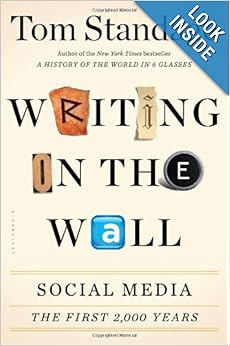
Image: Behind the scenes of Christian Twitter
There’s a conversation going on in the Christian twittersphere right now about the challenges posed by the internet for a sort of traditional complementarian view that women should not teach or exercise authority over men. There’s a stream of complementarianism that would extend these words from Paul to Timothy far beyond the event of the gathered church (and streams within complementarianism that see this prohibition of ‘teaching and exercising authority’ as a very particular role within that gathering; it’s a broad church).
The firestarter was this piece from Tish Harrison Warren on Christianity Today ‘Who’s In Charge of The Christian Blogosphere’, there’ve been responses (apart from Twitter flame wars) from writers like Jonathan Merritt, Wendy Alsup, Hannah Anderson and Rachel Miller. These are all worth a read and a mull over (and I’m sure there are plenty more to read too). I’ve been sharing a few of these on Facebook, and I suspect some of the people joining in on the discussion have perceived my obtuse quoting and introductory comments like ‘Interesting…’ as endorsements; it’s not necessarily any one piece here that I endorse (though there’s much to appreciate in many of them, and I have learned from them (or been taught by them)), it’s the conversation itself I find fascinating because what is playing out here is a new reformation of sorts; the question will be what scope and size of change this reformation brings… it’s possible that the democratised landscape where there’s already lots more diversity simply means conversations like this are a flash in a pan, where once they might have overhauled the church as we know it…
There’s an irony here that each of these writers writes from the Protestant tradition and what’s at stake is how a new communication medium makes us rethink the role of authority and who is in the ‘priesthood’. In the year where we’re marking 500 years since Luther used the printing press and a stream of fellow pamphleteers to bring down the Catholic establishment; the challenge these writers are responding to, or conversing around, is one brought about by an even more frictionless and democratised communication platform. It might seem odd that it has taken so many years of the Internet for us to get here… except that it’s not odd, because what is happening here is another reformation of sorts; another challenging of the establishment ‘priesthood’ (at least as it operates, if not as it is conceived, within some streams of the ‘complementarian’ church).
There are legitimate criticisms directed at this conversation from those who aren’t stakeholders in it; it seems wrong that the controversy only really kicked off the way it did when a woman, contributing to Christianity Today’s campaign to #amplifywomen, wrote about some of the dangers (to the establishment/’orthodoxy’) presented by this new platform, why single out a blogging woman like American blogger Jen Hatmaker to raise concerns about teaching and authority outside ‘church structures’ when we haven’t kicked up the same stink about controversy-monger/outrage-peddler Matt Walsh (who, for what it’s worth, is Catholic, so there’s a sort of double irony if what he’s doing is acting like a child of the Reformation). It feels like an attack on the ‘theological left’ when we give the ‘theological right’ a free pass; and worse, an attack on a woman, when we give men a free pass.
It’s not a mistake to make this a gender issue though, and an issue prompted by women teaching with some sort of authority; at least if we view the conversation in the schema of the Reformation using its categories; because it really is a question of whose voices are priestly, who can speak as part of, or on behalf of, the church — and what happens when these speakers depart from orthodoxy? What would Luther have done to the next generation of Luthers who out-Luthered him? If you’re a keen enough student of Reformation history you’ll know that the fighting about Orthodoxy 2.0 didn’t stop after the schism from the Catholic Church, and that the seeds of what we’re dealing with now, in terms of a very diverse publishing industry for Christian readers (much more diverse than the duplication of the Vulgate (the Latin Bible) kicked off with the Reformation.
It’s easy to scoff at this conversation (as some are in the habit of doing on social media) especially when people are trying to tease out what exactly a woman’s role could or should be in the church (if you’ve already decided to embrace a more egalitarian framework). But this is a question of the sort of practical order that prompted the Reformation, presented, in part, by a very similar technological advancement. The introduction of a ‘democratising’ piece of technology in the printing press meant lots more people could read lots more stuff lots more quickly… and social media/the blogosphere with its essentially frictionless and costless publishing is the printing press on steroids, and it could (and maybe should) have a similar seismic impact on the church. For good or for ill.
And that’s why this conversation is an important and interesting one.
It’s asking what responsibility in the face of almost unfettered access to a platform should look like (which we should be asking in an age of fake news, and Donald Trump anyway).
It’s asking what role the established institutional church, its traditions and its office bearers should play in determining what teaching is orthodox or Biblical (in content and mode); an irony faced whenever the anti-establishment movement becomes the establishment…
It’s asking in what sense we really believe in the priesthood of all believers, and what accountability in the life of the church looks like beyond those who take ordination vows or vows that submit themselves to church discipline within established structures (cause we’ve seen some pretty heinous forms of people setting up their own platforms apart from accountability (like a church in Seattle)).
It’s asking in what sense the Reformation really happened; do we really have a priesthood of all believers and what does that look like for women, and how do we have a priesthood of all believers with a 1 Corinthians 12 picture of church life and specific roles, and a sense that some of these roles might involve gender…
It’s we’re asking how the internet and the life of the universal church beyond a particular locality is like, or different, to a community that lives and gathers together as a particular expression of the body of Christ; and where authority fits in this picture.
It’s asking all these questions in the face of this new technological age which does inherently favour a particular theology and practice. The Internet is not neutral when it comes to these questions. A democratising platform operates in favour of egalitarian practices. Australian author Jane Caro made a pretty great case for this in an article back in January that is now paywalled; but I managed to quote this paragraph from her on Facebook at the time:
“As education and knowledge spread, Enlightenment followed theReformation, and then all the liberation movements that emerged thereafter, including the abolition of slavery, child labour, and increased rights for women. After all, if every man could have his own relationship with God, why not every woman? Why not every slave?
This democratisation of the word of God led inexorably to democracy itself; predicated on the idea that all men (even, perhaps, women) were created equal. Everyone ended up entitled to not just a relationship with God but with a vote and a say. One followed inevitably, I think, from the other. As those in power understand only too well, once a few difficult questions began to be asked, a great many more would follow.”
Whichever side you land on these questions there are lessons to be learned from the Reformation; even stepping aside from which side of the Reformation had a grasp of the truth there are lessons to learn here. You could be a Catholic complementarian, or a Protestant egalitarian, or anywhere on the spectrum between the two and history would be informative here. This isn’t just a conversation that matters for those facing the reformers with a new media strategy (and as a protestant in a Reformed denomination it shouldn’t surprise you which side I think had the better material to work with). There’s a pretty compelling case to be made that the Reformation ‘won’ where it won precisely because of its media strategy, and particularly because the media practices of the reformers lined up with their theology. You couldn’t really be a Catholic and employ the techniques the reformers employed if part of your theology was a belief that somehow the priesthood was set apart from the rest of the church not just in function, but by language, to play the game of engaging with the masses in the vernacular was to cede quite a bit to the reformers in a way that would’ve started to give some credence to their broader critique; while on the flipside, believing in a ‘priesthood of all believers’ meant there was less centralised control over the messaging of the Reformation, and anybody who had access to a printing press could, and should, use it to proclaim the theology of the Reformation; the Gospel.
The media practices of the Reformation were one of the driving forces behind my thesis (which looked at the media practices of the wisdom literature, Paul, Augustine, and Luther as historic case studies of communicators who had their practice shaped by their theology), I say this to acknowledge that this is an area I think is much more fascinating and fruitful than the average person on the internet… and to acknowledge that I may well be overthinking this present conversation; I’ve done lots of thinking and writing about this stuff… and lots of this thinking was prompted by an excellent Economist article How Luther Went Viral by Tom Standage, who would later write an excellent book on ‘democratised’ communication via Social Media called Writing On The Wall that’s worth a read if any of this interests you at all (here’s a TEDx talk with some of my thoughts, and a review of the book). In the Economist piece, Standage says:
“IT IS a familiar-sounding tale: after decades of simmering discontent a new form of media gives opponents of an authoritarian regime a way to express their views, register their solidarity and co-ordinate their actions. The protesters’ message spreads virally through social networks, making it impossible to suppress and highlighting the extent of public support for revolution. The combination of improved publishing technology and social networks is a catalyst for social change where previous efforts had failed.”
This is, in many ways, a summary of the current discussion (and what has prompted it), but it is Standage describing the Reformation. Here’s his description of the mechanisms of the viral Reformation:
“The media environment that Luther had shown himself so adept at managing had much in common with today’s online ecosystem of blogs, social networks and discussion threads. It was a decentralised system whose participants took care of distribution, deciding collectively which messages to amplify through sharing and recommendation. Modern media theorists refer to participants in such systems as a “networked public”, rather than an “audience”, since they do more than just consume information. Luther would pass the text of a new pamphlet to a friendly printer (no money changed hands) and then wait for it to ripple through the network of printing centres across Germany.
Unlike larger books, which took weeks or months to produce, a pamphlet could be printed in a day or two. Copies of the initial edition, which cost about the same as a chicken, would first spread throughout the town where it was printed. Luther’s sympathisers recommended it to their friends. Booksellers promoted it and itinerant colporteurs hawked it. Travelling merchants, traders and preachers would then carry copies to other towns, and if they sparked sufficient interest, local printers would quickly produce their own editions, in batches of 1,000 or so, in the hope of cashing in on the buzz. A popular pamphlet would thus spread quickly without its author’s involvement.”
And here’s where his opponents, the Catholic establishment, failed:
“Most of the 60 or so clerics who rallied to the pope’s defence did so in academic and impenetrable Latin, the traditional language of theology, rather than in German. Where Luther’s works spread like wildfire, their pamphlets fizzled. Attempts at censorship failed, too. Printers in Leipzig were banned from publishing or selling anything by Luther or his allies, but material printed elsewhere still flowed into the city. The city council complained to the Duke of Saxony that printers faced losing “house, home, and all their livelihood” because “that which one would gladly sell, and for which there is demand, they are not allowed to have or sell.” What they had was lots of Catholic pamphlets, “but what they have in over-abundance is desired by no one and cannot even be given away.”
Another key factor behind the success of the Reformation, according to Andrew Pettegree, a scholar Standage quotes (from a book called “Reformation and the Culture of Persuasion”) was the sheer volume of work published and distributed, even though it was published against the weight of traditional institutional authority:
“It was the superabundance, the cascade of titles, that created the impression of an overwhelming tide, an unstoppable movement of opinion…Pamphlets and their purchasers had together created the impression of irresistible force.”
Standing in the practical tradition of the Reformers should mean looking at new technologies — especially ‘democratising’ technologies that level the playing field by giving all people a voice — as opportunities to share the Gospel. To embrace new technologies to share our theology is part of our DNA… and at some point sharing, writing about, and discussing the Gospel is going to feel a lot like teaching… which presents some real challenges to people whose theology and practice is to see teaching and authority in the church as the domain of men. We might talk about a priesthood of all believers; but in practice in most churches in our tradition, we’ve very much got a priestly model tied to the pulpit, eldership, and the male-dominated (or exclusively male) governance structures of our churches. This isn’t a new question. Complementarians have had to grapple with women who write books for many years, and often do make a distinction between what happens in corporate worship and what happens in the broader life of the church; this is a distinction often not recognised by people outside the big-R Reformed scene; some of us make much of ‘WORSHIP’ in the super-capitalised Lord’s Day sense (others of us are puzzled at where the idea that there’s a major difference in the life and practice of the church between the Sunday gathering and all other communal life as depicted in the New Testament actually comes from).
For the big-R Reformed complementarian types there’s a scary scenario where one might have to put themselves in the shoes of the Reformation era Catholics to figure out how they could’ve kept the farm in the face of a new media strategy and new orthodoxy, because the risk, if this group’s position is correct, is that it will be overwhelmed if the response isn’t nimble and imaginative, but also theologically coherent.
For those of us who stand in the Reformed tradition but are more inclined to be ‘reformational’ (always reforming) than historically reformed, there are some opportunities here to ask ourselves some pretty confronting questions about whether our media practices actually do line up with our professed theology; a priesthood of all believers; both men and women. And this is why I, personally, think this conversation is particularly important and worth following even if some of the articles linked above don’t really nail where I’m coming from or think we should be going…
Luther was sure his words were going to be held to account by God; and in some sense his speaking was an act of attempting to hold others to account to God’s word, but also to traditions he believed the church had walked away from. We can’t simply dismiss the voices of our forbears as though we moderns are more enlightened or our pressing questions more pressing… In purely effective terms, Luther is almost without peer as a communicator and an example of someone who grasped hold of a new technology to great effect. He’s also, for all his faults, a great model of harnessing the power of new mediums to promote theological reforms he believed were necessary, and grappling with the questions of institutional authority that follow… these words from the Diet of Worms (where he may or may not have said ‘here I stand, I can do none else’) are a reasonable starting point, and perhaps ending point, in this conversation for all of us:
“I am bound by the texts of the Bible, my conscience is captive to the Word of God, I neither can nor will recant anything, since it is neither right nor safe to act against conscience.”
What that looks like… well. Let’s keep talking, and listening.


